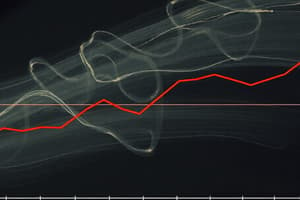Podcast
Questions and Answers
Which quantity is considered a scalar and is calculated by dividing the distance traveled by the time taken?
Which quantity is considered a scalar and is calculated by dividing the distance traveled by the time taken?
- Direction
- Speed (correct)
- Acceleration
- Velocity
What is the unit of measurement for acceleration?
What is the unit of measurement for acceleration?
- Seconds (s)
- Feet per second (ft/s)
- Meters per second (m/s)
- Meters per second squared (m/s²) (correct)
How is velocity different from speed?
How is velocity different from speed?
- Speed includes only magnitude, while velocity includes both magnitude and direction (correct)
- Velocity includes only magnitude, while speed includes both magnitude and direction
- Velocity is measured in feet per second (ft/s), and speed is measured in meters per second (m/s)
- Velocity is scalar, and speed is vector
What does an object's acceleration indicate?
What does an object's acceleration indicate?
What does the slope of a distance-time graph represent?
What does the slope of a distance-time graph represent?
Which type of motion produces a straight horizontal line on a distance-time graph?
Which type of motion produces a straight horizontal line on a distance-time graph?
What does the equation Distance (s) = (Initial speed × Time) + (1/2) × Acceleration × Time² describe?
What does the equation Distance (s) = (Initial speed × Time) + (1/2) × Acceleration × Time² describe?
Which equation is used for calculating the distance traveled by integrating the velocity function with respect to time?
Which equation is used for calculating the distance traveled by integrating the velocity function with respect to time?
What is described by the equation Velocity (v) = Initial velocity (u) + Acceleration (a) × Time (t)?
What is described by the equation Velocity (v) = Initial velocity (u) + Acceleration (a) × Time (t)?
How can we deduce an object's acceleration from a distance-time graph?
How can we deduce an object's acceleration from a distance-time graph?
Flashcards are hidden until you start studying
Study Notes
Navigating the SSST: Understanding Speed, Acceleration, Velocity, and Distance-Time Graphs in Motion
When discussing the "10 s.s.t" acronym, it seems that "10 Simple Scientific Topics" is being referenced, rather than any specific technical terms directly related to physics. In this article, we'll examine motion-related concepts such as speed, acceleration, velocity, and distance-time graphs, providing a detailed exploration of these fundamental principles.
Speed
Speed is a scalar quantity that describes an object's motion in the direction of its displacement. It is calculated by dividing the distance traveled by the time taken to cover that distance. The symbol for speed is "s" or "v," and the unit of measurement is meters per second (m/s) or feet per second (ft/s) for distance and seconds (s) for time.
Acceleration
Acceleration is a vector quantity that indicates the rate at which an object's speed changes. It is calculated by dividing the change in velocity by the time taken for that change. The symbol for acceleration is "a," and its unit of measurement is meters per second squared (m/s²) or feet per second squared (ft/s²).
Velocity
Velocity is a vector quantity that describes an object's motion with both speed and direction. It is calculated by multiplying the speed by the direction vector. The symbol for velocity is "v" or "u," and its unit of measurement is the same as that for speed.
Distance-Time Graphs
A distance-time graph is a graphical representation of how an object's displacement changes with time. The horizontal axis represents time, while the vertical axis represents distance. On a distance-time graph, the slope of the line at any given point indicates the object's instantaneous speed at that moment.
A motion that has a constant speed will produce a straight horizontal line on the distance-time graph, while a motion that has a varying speed will produce a curved line. By analyzing the graph, we can deduce the object's instantaneous speed, acceleration, and direction of motion.
Motion Equations
There are several motion equations that describe the relationships between speed, acceleration, and distance in different scenarios:
- Displacement (s) = Initial distance (s₀) + Speed (v) × Time (t)
This equation is valid when an object moves with a constant speed.
- Velocity (v) = Initial velocity (u) + Acceleration (a) × Time (t)
This equation is valid for an object undergoing uniformly accelerated motion.
- Distance (s) = (Initial speed × Time) + (1/2) × Acceleration × Time²
This equation is valid for an object undergoing uniformly accelerated motion.
- Distance (s) = ∫v dt
This equation is valid for any type of motion. It calculates the distance traveled by integrating the velocity function with respect to time.
These equations provide a powerful tool that helps us understand and model the motion of objects under various circumstances, including free fall, projectile motion, and more.
In summary, speed, acceleration, velocity, and distance-time graphs are fundamental concepts in physics that help us describe and analyze the motion of objects. Understanding these principles allows us to make predictions, solve problems, and better comprehend our world.
Studying That Suits You
Use AI to generate personalized quizzes and flashcards to suit your learning preferences.




